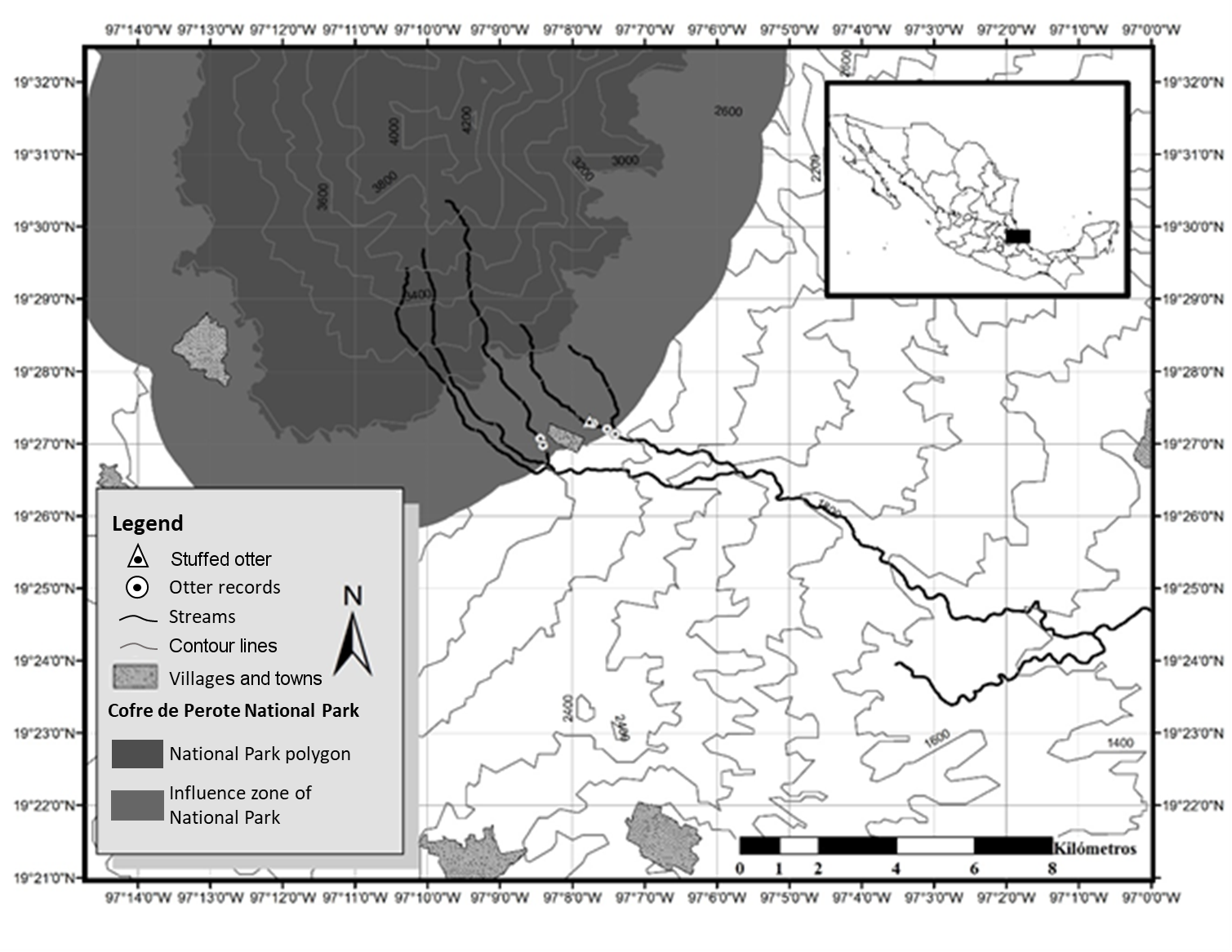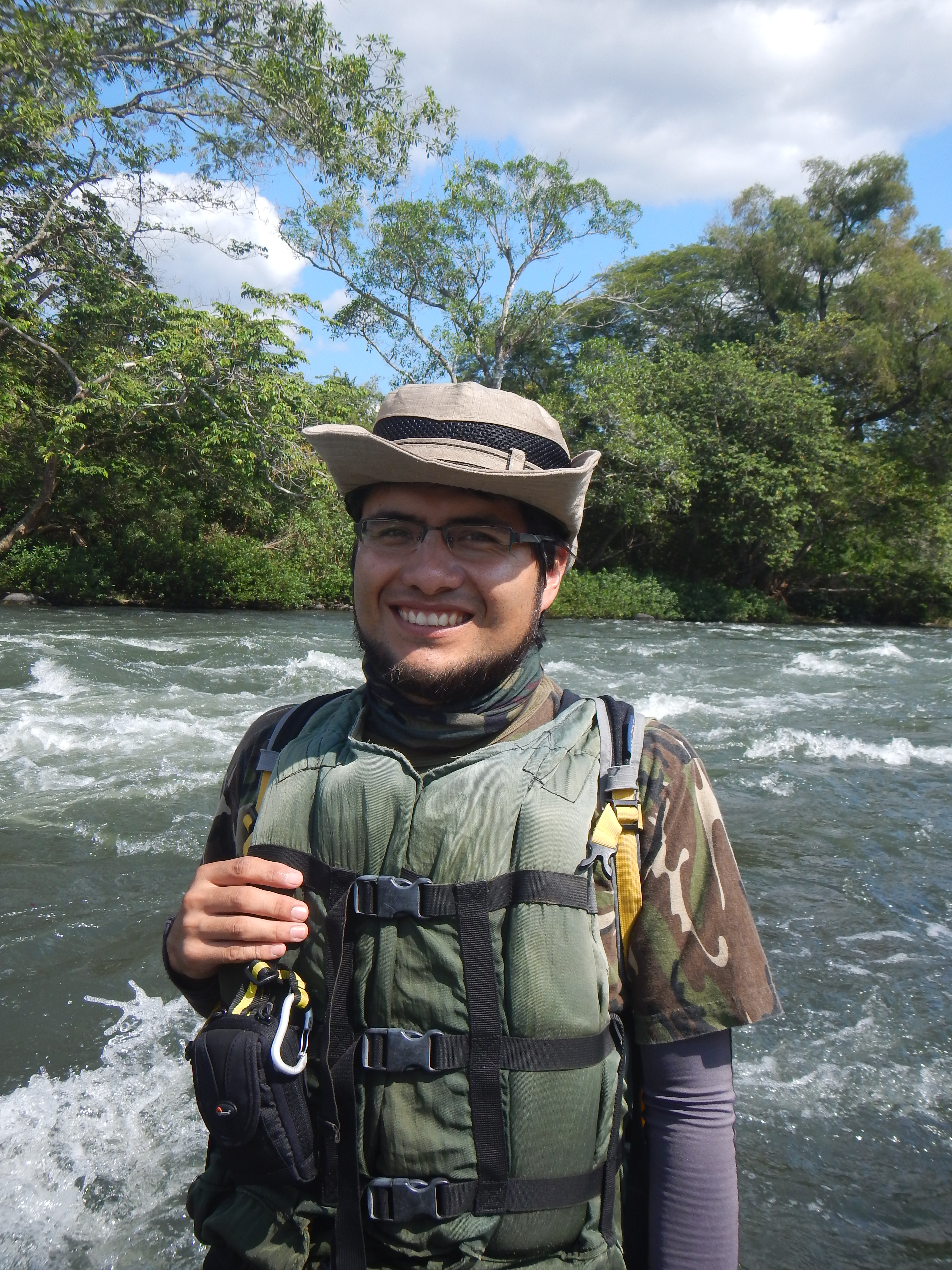IUCN/SSC Otter Specialist Group Bulletin

©IUCN/SCC Otter Specialist Group
Volume 35 Issue 4 (December 2018)
Citation: Hernández-Romero, PC, Botello López, FJ, Hernández García, N and Espinoza Rodríguez, J (2018). New Altitudinal Record of Neotropical Otter (Lontra longicaudis Olfers, 1818) and Conflict with Fish Farmers in Mexico. IUCN Otter Spec. Group Bull. 35 (4): 193 - 197
New Altitudinal Record of Neotropical Otter (Lontra longicaudis Olfers, 1818) and Conflict with Fish Farmers in Mexico
Pablo César Hernández-Romero1, Francisco Javier Botello López2, Noé Hernández García3 and Jaime Espinoza Rodríguez1
1 Departamento de Monitoreo Biológico y Planeación de Conservación, Conservación Biológica y Desarrollo Social, A. C. Calle Nueve, Núm. 52, Int. 4, Colonia Espartaco, Coyoacán, 04870, Ciudad de México, México.Corresponding author: pablohernandez@conbiodes.com
2 Departamento de Zoología, Instituto de Biología, Universidad Nacional Autónoma de México, Coyoacán, 04510, Ciudad de México, México.
3 Parque Nacional Pico de Orizaba-CONANP, Ciprés #21 Col. Venustiano Carranza, 91070, Xalapa, México. Calle Nueve 52 Int.4, Ciudad de México, 04870, México.
Received 26th February 2018, accepted 8th May 2018
Abstract: The Neotropical otter has a wide distribution in the Neotropics, including Mexico, where is listed as a threatened species, but there remain many unknown aspects of its ecology and distribution. A participatory monitoring committee was established to conduct field monitoring to document the presence of the Neotropical otter in the community of Tonalaco, located in the National Park Cofre de Perote in Veracruz State, México. Interviews were carried out with local inhabitants of Tonalaco to obtain information about the presence of the species. The present study documents a new elevational record for the neotropical otter in Mexico. Scats were found in the area, and a local resident possessed a stuffed specimen hunted in the area. Ranchers and cultivated trout producers of Tonalaco were not aware of the presence of the species before 2014. Our study provides new information about the presence of otter in the mountains of Mexico, outside of optimal habitat for the species. It is likely that fish farms have allowed otters to move into the area, but this has created a conflict between trout farmers and otters. Management strategies for the conservation of the species in this and other similar areas in Mexico need to be developed.
Keywords: Neotropical otter, elevational distribution, human-otter conflict, conservation, Veracruz
INTRODUCTION
Knowledge of the distribution of a species allows an understanding its biological requirements (Brown et al., 1996), especially important for species with protected status. The Neotropical otter, (Lontra longicaudis) has a wide distribution in freshwater ecosystems from northern Mexico to Argentina (Larivière, 1999). In Mexico, its distribution is continuous from the southern part of the country to the Trans-Mexican Volcanic Belt, where it is restricted by the central highlands (Gallo-Reynoso 1997). The Neotropical otter inhabits a wide variety of aquatic environments, including rivers, lakes, mangroves, wetlands and coastal lagoons, and often co-exists with human activities (Monroy-Vilchis and Mundo 2009). Neotropical otters have been reported from sea level up to a maximum elevation of 2,200 m.a.s.l (Charre-Medellín et al., 2011, Santos-Moreno et al., 2003, Servín et al., 2003). However, the two South American subspecies of L. longicaudis (L. l. enudris and L. l. longicaudis) have been recorded at elevations around 3,000 m.a.s.l. in Ecuador, Colombia and Argentina (Andrade-Ponce and Angarita-Sierra, 2017; Castro-Revelo and Zapata-Ríos, 2001; Eisenberg and Redford, 1999).
This species has a flexible diet and is considered opportunistic in its feeding habits (Rheingantz et al., 2017), although more than 85% of its diet in Mexico is composed of fish and crustaceans (Briones-Salas et al., 2013; Duque-Dávila et al., 2013; Rheingantz et al., 2017). Despite this versatility, the presence of otters in aquatic habitats is limited by the quantity of food available (Latorre-Cárdenas, 2013) and the quality of the habitat, such as preserved riverbanks, low human disturbance, refuge availability and clean water (Carrillo-Rubio and Lafón, 2004; Hernández-Romero, 2011).
The community of Tonalaco (longitude -97°07'42.9'', latitude 19°25'51.9'') is located in the municipality of Xico in central Veracruz State at an elevation of 2,600 m.a.s.l. (Fig. 1). The predominant vegetation is pine-oak forest. The Magueyitos and Temazate Rivers have water levels less than 1m deep for most of the year, and there are high rates of deforestation on the riverbanks--negative elements for good otter habitat. Also, the Tonalaco area has an intensive production of cultivated rainbow trout (Oncorhynchus mykiss), a species introduced to the area and other regions in Mexico. Trout are produced in ground-level ponds near the Magueyitos and Temazate Rivers. The local inhabitants indicate that traditional fishing in the streams is poor because of overfishing. While trout aquaculture may attract otters, other habitat conditions are unfavorable in these highlands (Andrade-Ponce and Angarita-Sierra, 2017; Guerrero-Flores et al., 2013).

(click for larger version)
Between August and December 2015, as part of a study to verify the presence of the otter in the area of influence of the Cofre de Perote National Park (PNCP), monitoring teams, together with people from Tonalaco and the staff of Cofre de Perote National Park, searched for evidence of neotropical otters in the area. Monitoring was carried out several times in the Magueyitos and Temazate streams. Additionally, 30 informal interviews were conducted with the local inhabitants, who were asked about the presence of otters in the area.
We obtained evidence of the presence of Neotropical otters in the Tonalaco region at 2,500 m.a.s.l., higher than previously reported in Mexico for the species. Evidence consisted on scats, tracks and reports of sightings of the species in both streams by the local people (Table 1). Otter presence was confirmed by a stuffed otter, an adult male specimen, killed in 2014 by a trout producer in the Temazate River (19 ° 25'52.59 "N, 97 ° 7'35.46" W, 2,550 m.a.s.l.) (Figure 2). Locals also reported the capture of another adult individual in a trap, in the same year and in the same river, although the otter managed to escape.
Most of the interviewees, including older people and trout producers, indicated that they has not seen the species before 2014, when otters were first observed visiting the trout ponds to feed. This caused the local people to begin to hunt and kill them (Figure. 2).

(click for larger version)
The unfamiliarity of the inhabitants (mainly the older ones) with otters suggests that they have only recently migrated into the area, possibly due to an increase in food availability due to escaped rainbow trout. Otters may be migrating upstream from the larger La Antigua River, into which these two rivers flow. This highland area does not present adequate natural habitat for the species, but is apparently adequate when supplemented by introduced cultivated fish species, causing an artificial expansion of the otters’ range (Andrade-Ponce and Angarita-Sierra, 2017; Guerrero-Flores et al., 2013).
Although the presence of neotropical otters in the area appears to be recent, their depredation of cultivated fish has created a conflict with fish farmers. A negative perception of the otters is causing the animals to be hunted, threatening their survival in the area. We recommended an assessment of the impact of otters on fish farming in the region, and the establishment of a monitoring and assessment program for the resolution of the conflict.
Acknowledgements: This work was carried out thanks to the NGO Conservación Biológica y Desarrollo Social, A.C. (CONBIODES), the National Commission of Natural Protected Areas (CONANP, PROCER: Conservation of habitat and monitoring of neotropical otter in Mexico), especially the Director and staff members of the Cofre de Perote National Park for their support in monitoring the presence of the otters and for establishing contact with local communities. Many thanks to the trout producers and residents of Tonalaco for their participation in the field work and the information provided.
REFERENCES
Andrade-Ponce, G.P., Angarita-Sierra, T. (2017). Notable altitudinal range expansion of Lontra longicaudis (Carnivora: Mustelidae) in Colombian Paramos. Therya. 8:75-78.
Briones-Salas, M., Peralta-Pérez, M.A., Arellanes, E. (2013). Análisis temporal de los hábitos alimentarios de la nutria neotropical (Lontra longicaudis) en el rio Zimatán en la costa de Oaxaca, México. Therya. 4:311-326.
Brown, J. H., Stevens, G.C., Kaufman, D.M. (1996). The geographic range: size, shape, boundaries, and internal structure. Annual Review of Ecology and Systematics. 27:597–623.
Carrillo-Rubio, E., Lafón, A. (2004). Neotropical river otter micro-habitat preference in west-central Chihuahua, Mexico. IUCN Otter Specialist Group Bulletin.21:10-15.
Castro-Revelo, I., Zapata-Ríos, G. (2001). New altitudinal record of Lontra longicaudis (Carnivora: Mustelidae) in Ecuador. Mammalia. 65:237-239.
Charre-Medellín, J.F., López-González, C., Lozano, A., Guzmán, F.A. (2011). Conocimiento actual sobre la nutria neotropical (Lontra longicaudis annectens) en el estado de Durango, México. Revista Mexicana de Biodiversidad. 82: 1343-1347
Duque-Dávila, D.L., Martínez-Ramírez, E., Botello-López, F., Sánchez-Cordero, V. (2013). Distribución, abundancia y hábitos alimentarios de la nutria (Lontra longicaudis annectens Major, 1897) en el Río Grande, Reserva de la Biosfera Tehuacán-Cuicatlán Oaxaca, México. Therya. 4:281-296.
Eisenberg, J. F. abd Redford, K. H. (1999). Mammals of the Neotropics: The Central Neotropics. Chicago and London, The University of Chigago. 609p
Gallo-Reynoso, J.P. (1997). Situación y distribución de las nutrias en México, con énfasis en Lontra longicaudis annectens Major, 1987. Revista Mexicana de Mastozoología. 2:10-32.
Guerrero-Flores, J.J., Macías-Sánchez, S., Mundo-Hernández, V., Méndez-Sánchez, F. (2013). Ecología de la nutria (Lontra longicaudis) en el municipio de Temascaltepec, Estado de México: estudio de caso. Therya, 4:231-242.
Hernández-Romero, P.C. (2011). Abundancia poblacional y preferencia de hábitat de la nutria neotropical (Lontra longicaudis annectens Major, 1897) en el Río Grande, Cuicatlán Oaxaca. Tesis de maestría. Instituto de Ecología, A.C. 77pp.
Latorre-Cárdenas, M.C. (2013). Evaluación del estrés fisiológico, la bioacumulación de contaminantes persistentes y la calidad del hábitat de la nutria neotropical en Veracruz, México. Tesis de Maestría. Instituto de Ecología, A.C. 86pp.
Larivière, S. (1999). Lontra longicaudis. Mammalian Species, 609:1-5.
Monroy-Vilchis, O and Mundo , V (2009). Nicho trófico de La nutria netropical (Lontra longicaudis) em um ambiente modificado, Temascaltepec, México. Rev Mex Biodivers 80: 801-806
Rheingantz, M.L., de Menezes, J.F.S., Galliez, M., dos Santos, F.A.F. (2017). Biogeographic patterns in the feeding habits of the opportunist and semiaquatic Neotropical otter. Hydrobiologia, 792: 1. DOI 10.1007/s10750-017-3095-5.
Santos-Moreno, J.A., M. Briones-Salas, G. González-Pérez., Ortiz, T. de J. (2003). Noteworthy records of two rare mammals in Sierra Norte de Oaxaca, Mexico. The Southwestern Naturalist, 48:312-313.
Servín, J., Chacón, E., Alonso-Pérez, N., Huxley, C. (2003). New records of mammals from Durango, México. The Southwestern Naturalist, 48:136-138.
Resumé: Nouveau Record d’Altitude Pour La Loutre à Longue Queue (Lontra Longicaudis, Olfers, 1818) et Conflit avec des Pisciculteurs au Mexique
La loutre à longue queue a une large répartition dans les tropiques, en ce compris au Mexique, où elle est considérée comme une espèce menacée . Cependant, il subsiste de nombreux aspects méconnus de son écologie et de sa répartition. Un comité de suivi participatif a été mis en place pour effectuer un suivi sur le terrain afin de mettre en évidence la présence de la loutre à longue queue dans la communauté de Tonalaco, située dans le parc national Cofre de Perote, dans l’État de Veracruz, au Mexique. Des entretiens ont été menés avec des habitants de Tonalaco pour obtenir des informations sur la présence de l’espèce. La présente étude relate un nouveau record d’altitude pour la loutre à longue queue au Mexique. Des épreintes ont été trouvées dans la région, et un habitant local possédait un spécimen empaillé chassé dans la région. Les éleveurs et les producteurs de truites de Tonalaco n’étaient pas au courant de la présence de l’espèce avant 2014. Notre étude fournit de nouvelles informations sur la présence de loutre dans les montagnes du Mexique, en dehors de l’habitat optimal pour l‘espèce. Il est probable que les pisciculteurs ont permis aux loutres de se déplacer dans la région, mais cela a créé un conflit entre éleveurs de truites et les loutres. Des stratégies de gestion pour la conservation de l’espèce dans cette zone et dans d’autres zones similaires du Mexique doivent être développées.
Revenez au dessus
Resumen: Nuevo Registro Altitudinal De La Nutria Neotropical (Lontra Longicaudis Olfers, 1818) Y Conflicto Con Piscicultores En México
Es fundamental conocer las áreas de distribución de las especies y las condiciones ambientales que delimitan éstas distribuciones para el establecimiento de estrategias adecuadas de conservación. La nutria neotropical, Lontra longicaudis, es una especie con una amplia distribución a lo largo del Neotrópico incluyendo en México, donde es una especie amenazada. Sin embargo se desconocen aún varios aspectos sobre su ecología y distribución. Se conformó un comité de monitoreo participativo con pobladores locales para realizar muestreos para encontrar evidencia de la presencia de la nutria en la comunidad de Tonalaco ubicada en la zona de influencia del Parque Nacional Cofre de Perote. El presente estudio muestra un nuevo registro altitudinal para la nutria neotropical en México. Los pobladores y productores de truchas de Tonalaco no tenían conocimiento de la presencia de la especie en la zona antes de la colocación de estanques de trucha arcoíris en el 2014. Los resultados aportan nueva información sobre la presencia de la nutria en ambientes montañosos de México, donde las condiciones ambientales no presentan las características óptimas descritas para la especie, sin embargo la presencia de la nutria en la zona podría estar dada por los criaderos de truchas que ahí se han establecido. Esta actividad productiva presenta un conflicto entre productores de truchas y la nutria en la zona, lo cual debe evaluarse para proponer estrategias de manejo y conservación de la especie en ésta y otras zonas con condiciones similares de México.
Vuelva a la tapa



